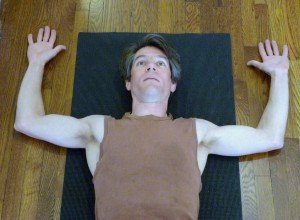 Forward head posture, the topic of many recent posts, has a tendency to round the shoulders forward and the upper spine backward.
Forward head posture, the topic of many recent posts, has a tendency to round the shoulders forward and the upper spine backward.
Working to open the chest can bring a great deal of relief and space to the head and neck.
The pose in the video is one of my favorites, Cactus On The Back. It works passively to open the chest and can be very effective if done daily for ten (or more) minutes at a time.
Everyone has different things they are working on in terms of tight muscles.
Ideally, when you lay on your back and bring your arms to this cactus position the whole trunk will be flat to the floor except for the lower back and the neck.
My neck has a large (too large) curve and is probably 2″ off the floor while my lower spine is about 1/2″ off the floor. Everyone is different
The latissimus dorsi is a big broad muscle of the back that connects the arm to the spine and pelvis. Cactus On The Back is a kind of test of this muscle.
When you are lying on your back with the arms in this position the base of the ribcage, the backs of the wrists, and all ten fingers aspire to be flat on the floor which is easier said than done.
A tight latissimus dorsi will pull the ribcage and, or, the wrists up away from the floor.
The pectoralis minor, a muscle profoundly affected by forward head posture, is allowed to broaden here and hopefully stretch a little under the weight of gravity as the arms release to the floor and the chest opens.
Forward head posture throws several upper back, chest, and neck muscles into disarray and Cactus On The Back is a great place to begin to open the chest passively and create the space for the head to move back in line towards the spine.
Cactus on the Back to Open the Chest
This falls somewhere between a release and a stretch and is not nearly as benign as some might think, though you won’t be doing much.
-
- Lie flat on your back with your knees bent and your feet flat on the floor. The feet should be hip distance apart or the heels should line up with the sit bones.
- Bring your arms out to the side and bend your elbows to form a right angle with the arms.
- Lengthen the back of the neck and allow the spine to soften toward the floor. The lower back and neck should each have a gentle arch, but ideally the rest of the spine should have contact with the floor. Move very slowly.
- Once you get your spine into a good place, bring your awareness to the forearms, wrists and hands. Open the hands, extending the wrists and the fingers. If your hands, wrists and forearms are up off of the ground put a folded towel or blanket under them for support.
- Allow the back of the body to lengthen, soften, and release.
***
